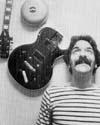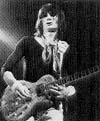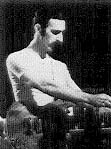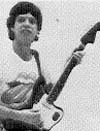By Peter Mengaziol
Ken Schaffer is the music biz’ GyroGearloose.
Whenever you see some guitar gonzo on stage
without an amp cord, you know he’s using one
of his remote gizmos.

“We listen to the radio in the office all day. But when Jimi Hendrix comes on that’s our cue. Someone yells ‘Jimi!’ and everything stops. We don’t answer the phone or do any work until the song is over. Then we go back to business as usual.”
Is this any way to run a business? Ken Schaffer makes money selling an impossible product: for about four grand you geta set of devices that add no special effects to your guitar sound, are smaller than a breadbox, yet many rock stars wouldn’t leave their dressing rooms without them. Ken has designed the ultimate replacement link between guitar and amp. It won’t crackle (like that cable you keep in the closet because it almost works), it won’t break if you yank on it and it won’tpick up hum. Ken’s replacement for the guitar cable is having no cable at all. In short, the wireless guitar connector. That’s how all those guitar heroes run around stage without tripping (up).
Ken’s fascination with radio waves has led him down some rather non-musical avenues. He began as a kid, wiring uphis own receivers out of tubes and electronic remainders scrounged frompiles of electronic scrap. In those days – pre-Radio Shack – if you lived in New York it meant going down to Courtlandt Street on a Saturday morning, getting there early before all your friends did, and maybe finding something precious for your pet project. In those days Courtlandt Street was synonymous with Hobbyists’ Heaven. That was years ago. Now only a few gadget stores remain and Courtlandt Street serves as little more than the border between theartsy Soho district and downtown Manhattan. It was here during the earlysixties that many future electronic whizzes first discovered the lure of cheap surplus parts.
Ken began working in music when he was sixteen, and his associations led to a close tie to Jim Hendrix around the time that Jimi began experimenting with new, extended, sorts of music. Ken sat in and listened to many of those afterhours sessions of 1969, helping to edit them for authorized release. Ken sometimes speaks of Jimi as if hewere in the next room sleeping.
“I was into radio since I’ve been 8 and I’ve been working in music since I’ve been 16. It was coincidental that both combined. In 1977, both combined and I applied radio to music to get the guitar into the amplifier.”
He’s been rather successful at it; at least successful enough to boast “nine out of ten bands in the Top Ten are wireless!” At this point in time only a few people can afford a Schaffer set-up. “We don’t want to sell shoes. We want to sell for high dollars to people whoo can’t afford anything less” The $4000 price tag is more than a statement of snobbery — it’s a reflection of the high cost of small production runs. Because his company is small and production has to remain in relatively few numbers, the entry fee is high. What gets thrown into the deal is personalized care and service to the musician.

The cost is also high because the standards are very high. To avoid drop-outs in reception due to movement, each wireless system, to be fully reliable, must have two completely independent receivers so that the system can pick the best signal to channel into the amp or PA. That costs money but the reliability is high and the results are so good that some people even use the wireless “n the studio because, believe it or not, in some cases the sound is better than if a cable were used!
Ken’s obsession with radio didn’t stop with guitar boxes. This year he has gotten involved with satellite transmission and reception in a big way. He consults for the networks and has done some supposedly impossible things, some of which sound Top Secret. He assuresus that it is technologically possible at present to hook up musicians via satellite and jam coast-to-coast or transoceanically. “It’s outthere if you can afford it. The only problem is the fractional second that it takes for even radio waves to cross vast territorial distance.”
While it would be nice to jam with someonemiles away, Ken’s research might be of use to musicians even in the short run, in the near future: “l can see that in five years the biggest option on an amp will be whether it is wireless or not. The price drop will make it commonplace. We have in our hands the means of transmission that would not tie you down to a specific site. That’s a convenience. We care about the media and we care about the content. Not whether it comes over a wire or a wireless. That is irrelevant to what you hearand should be transparent.”

Ron Wood:
“How long a back order?!?”
“Like the medium of tape should not degrade a signal from ‘live.’ The medium of wireless should not degrade a signal as opposed to wire. The medium of satellite should not degrade a signal as opposed to long lines. We’re at a point in time where the means of transmission are changing every week. Yeah, we’re all going to have Dick Tracy telephones on our wrists in about eight years’ time.”
With all his Gyro Gearloose explorations, willhe have time for rock and roll? “No I’m definitely not leaving rock and roll. That was one of our conditions for our financing. We started our satellite division by getting Moscow TV from Washington. All the investment bankers said ‘you’ve got to drop that rock and roll shit and we’ll finance the satellites with megabucks.’ I replied that I won’t be dropping my music. Music is a central medium.”

Frank Zappa:
“The performance is as incomprehensible as the price.”
Someone in Ken’s shoes, the Marconi of the Satellite Era, as some telecommunications people call him, could be a lot more smug. After all, Schaffer makes the most widely-used wireless and has a stellar list of clients reading like a Cashbox Top Forty chart. While the social implications of accessible communication have been hailed as revolutionary by media-ologists the contribution that Ken has made in the music field in its own way is evolutionary because of the freedom it imparts. When we asked him about any great sociological impact he smiled and said: “It’s another element of show biz. It will save a couple of lives and let rock stars run around the stage on hydraulic lifts. It has no redeeming social factors except that it will save some people’s lives by eliminating the possibility of electrocution, I don’t think that Angus of AC/DC running into the balcony is going to save the world!”
Mick Jagger:
“It’s awfully expensive for a replacement guitar cord wouldn’t you say?”

